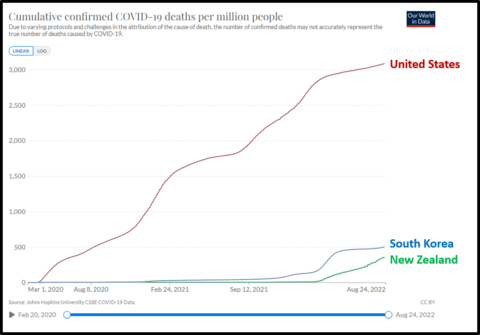A timeline
9/19/2020
I previously discussed an article from March 2020 by Drs. Eran Bendavid and Jay Bhattacharya titled “Is the Coronavirus as Deadly as They Say?” In this article, they wrote:
If it’s true that the novel coronavirus would kill millions without shelter-in-place orders and quarantines, then the extraordinary measures being carried out in cities and states around the country are surely justified.
While Dr. Bhattacharya later tried to pretend these words don’t mean exactly what they mean, he is not the sole author of the Great Barrington Declaration who has said things about these “extraordinary measures” that I agree with. On 9/19/2020, Dr. Martin Kulldorff said the following:
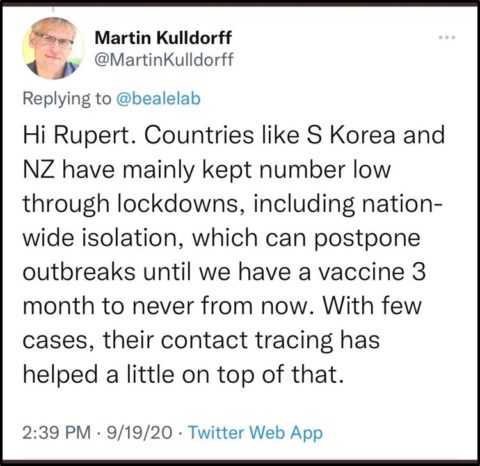
This seems eminently reasonable. For much of the pandemic, South Korea and New Zealand kept their COVID cases low through lockdowns to buy time for a vaccine.
10/4/2020
On 10/4/2020 The Great Barrington Declaration was published. It said:
Current lockdown policies are producing devastating effects on short and long-term public health. The results (to name a few) include lower childhood vaccination rates, worsening cardiovascular disease outcomes, fewer cancer screenings and deteriorating mental health – leading to greater excess mortality in years to come, with the working class and younger members of society carrying the heaviest burden. Keeping students out of school is a grave injustice.
Keeping these measures in place until a vaccine is available will cause irreparable damage, with the underprivileged disproportionately harmed.
The Great Barrington Declaration said that “those who are at minimal risk of death” should “live their lives normally to build up immunity to the virus through natural infection.” Even though Dr. Kulldorff recognized that vaccines might be several months away, he wanted those at “minimal risk” to contract COVID before they were vaccinated. It falsely claimed that “For children, the COVID-19 mortality risk is less than for the annual influenza“, and said:
We have seen only a handful of reinfections. If the virus is like other corona viruses in its immune response, recovery from infection will provide lasting protection against reinfection, either complete immunity or protection that makes a severe reinfection less likely.
12/08/2020
Happily, Dr. Kulldorff’s most optimistic projection about vaccines was spot on. Though the authors of the Great Barrington Declaration feared that “Keeping these measures in place until a vaccine is available will cause irreparable damage,” just two months later, something amazing happened. On 12/8/2020, 90-year-old Margaret Keenan stepped into history as the first person to receive a COVID vaccine outside of a clinical trial, and over the next several months, hundreds of millions of people were vaccinated in the fortunate parts of the world. The vaccines have since proven extremely effective at keeping people alive and out of the hospital.
Keep all this in mind when answering the question at the end of this article.
Lockdowns “postponed the inevitable”
The tweet that opened this essay is one example amongst many where Dr. Kulldorff acknowledged that lockdowns drastically slowed the spread of the virus. He’s repeatedly said that lockdowns “postponed the inevitable”, and in January 2022, he acknowledged that many people had been able to avoid the virus for nearly two years, writing “the laptop class is now getting infected with Covid”. Dr. Kulldorff and I fully agree that interventions such as lockdowns helped postpone SARS-CoV-2 infections for millions of people until after vaccines were available and medical care improved. We just disagree on whether or not this was a bad thing.
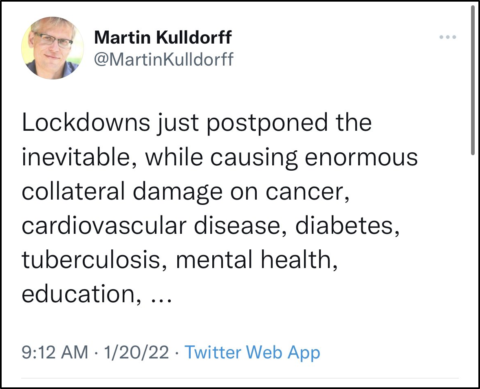
Lockdowns “postponed the inevitable”, unfortunately
While limiting COVID cases seemed to be an unambiguously good thing in the fall of 2020, when the population had negligible immunity and vaccines were plausibly just around the corner, the authors of the Great Barrington Declaration argued otherwise. Normal people feel the darkest days of the pandemic were immediately after vaccinations started in the winter of 2021, when 3,000 people were dying of COVID every day. However, proponents of infecting unvaccinated, young people reserve their outrage for the pandemic’s first months, when lockdowns prevented the virus from spreading. They wish more people had contracted the virus in 2020, and their pro-virus stance influenced politicians in many countries. For example, one headline from December 2020 declared:
‘We want them infected,’ Trump HHS Appointee Said in Email Pushing to Expose Infants, Kids and Teens to Covid to Reach ‘Herd Immunity’.
Though Dr. Kulldorff admits lockdowns helped postpone infections until vaccines were available, he views this a strike against them. Why is this?
Were he to admit that lockdowns were beneficial for this reason, he’d be conceding that the arrival of vaccines in December 2020 rendered the Great Barrington Declaration utterly obsolete, which of course, they did. Vaccines meant that those who had avoided the virus thus far had a very attractive alternative to “natural immunity”. In order to maintain the illusion that his plan had any relevance in a post-vaccine world, Dr. Kulldorff has been forced to disparage vaccines, lockdowns, and all other measures that limit the spread of the virus. He even had the audacity to complain on 12/19/2020 that “Spring #COVID19 #lockdowns simply delayed and postponed the pandemic to the fall”. The very week that vaccinations began in the US, and as the deadliest part of the pandemic was starting, he argued that it was a mistake that hundreds of millions of people had postponed their infection. Think about how ridiculous that is.
As lockdowns interfered with his plan to infect unvaccinated young people, Dr. Kulldorff now blames them for all sorts or maladies and issues unsubtle threats to decapitate those whom he deems “responsible”. He preposterously anointed himself as a spokesman for marginalized people and uses histrionic language to claim they continue to be harmed by lockdowns of varying stringency, that lasted several months, and ended nearly two years ago. For example, he wrote about the “devastating lockdown carnage on children, workers and the poor” and said lockdowns were “the worst assault on the working class since segregation and the Vietnam War“. He even blames lockdowns for variants, tweeting that they “Generate more contagious variants, increasing herd immunity threshold needed for endemic stage, so more people infected”. This is, of course, absurd, especially considering that in the same tweet he lamented that lockdowns “postpone infections”.
Even though 10 million children around the world lost a parent or caregiver to COVID, and 4 million Americans may be out of work due to long COVID, Dr. Kulldorff feels the “children, workers and the poor” would have been better off if the virus spread more freely among them before they were vaccinated. He’ll never acknowledge what the virus has done to the people for whom he imagines himself an advocate.

Vaccines also interfered with Dr. Kulldorff’s plan of herd immunity through mass infection, and to avoid recognizing their benefits, he now debases himself by consorting with anti-vaccine loons and fear mongering about vaccines based on a flawed study that misrepresents trial data. He absurdly argues that unvaccinated children should contract COVID because the flu is more dangerous. This is completely false, though even if it were true, this is not a valid argument against vaccinating children. With other viruses, Dr. Kulldorff recognizes it’s unacceptable for any child to suffer or die for lack of a vaccine. It’s only with COVID that he argues such suffering is tolerable because “the old have a thousand-fold higher mortality risk than the young”. This too is a ludicrous reason to let unvaccinated children suffer.
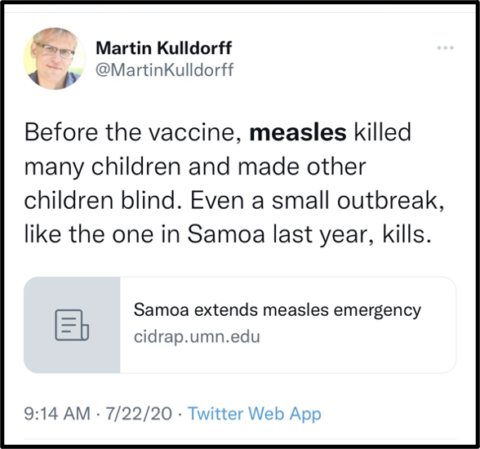
If vaccines put the Great Barrington Declaration’s relevance on life support, the emergence of highly contagious variants capable of reinfecting people struck the fatal blow. To evade this obvious reality, Dr. Kulldorff been forced to fetishize “natural immunity”, claiming that “The pandemic ends when enough people have natural immunity after Covid recovery. With herd immunity, we then enter the endemic stage”. Even after the arrival of variants with immune escape, he’s continued to act as a cheerleader for the virus. However, with reinfections now commonplace, it’s clear now that the only people who deny “natural immunity” are those who still claim it is robust and permanent. Even people with “natural immunity” benefit from vaccination, though Dr. Kulldorff won’t admit this either.
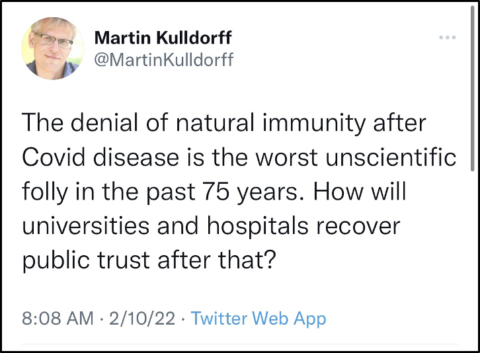
Because his real goal has always been to generate outrage about measures that limited “natural immunity”, Dr. Kulldorff never bothered to formulate a workable plan as for how societies might actually “protect the vulnerable”. Even though this was the “central aim” of the Great Barrington Declaration, it’s entire “plan” consisted of the following four sentences:
By way of example, nursing homes should use staff with acquired immunity and perform frequent testing of other staff and all visitors. Staff rotation should be minimized. Retired people living at home should have groceries and other essentials delivered to their home. When possible, they should meet family members outside rather than inside. A comprehensive and detailed list of measures, including approaches to multi-generational households, can be implemented, and is well within the scope and capability of public health professionals.
Beyond this, the “Frequently Asked Questions” section of the Great Barrington Declaration’s website contains a handful of bland suggestions, such as saying an “older family member might temporarily be able to live with an older friend or sibling, with whom they can self-isolate together during the height of community transmission”. However, such statements are mostly unactionable pablum that look great on paper, but in reality have the same sophistication as my childhood plan to end crime by “locking up all the bad guys”. As Noah Louis-Ferdinand, who actually worked in a senior center at the pandemic’s start, wrote in a must-read critique, “There was never any evidence that these flawed interventions could maintain zero COVID in one place despite rampant spread in the community”.
Despite the complete absence of any real plan to protect the vulnerable, Dr. Kulldorff incredibly claims that without lockdowns, herd immunity would have arrived in 3-6 months. Even though the Great Barrington Declaration was published after lockdowns had ended in many parts of the world and after it became clear that “natural immunity” didn’t lead to permanent immunity, Dr. Kulldorff insists he was “proven correct“, and the “pandemic would have been over” a year ago had we only listened to him.
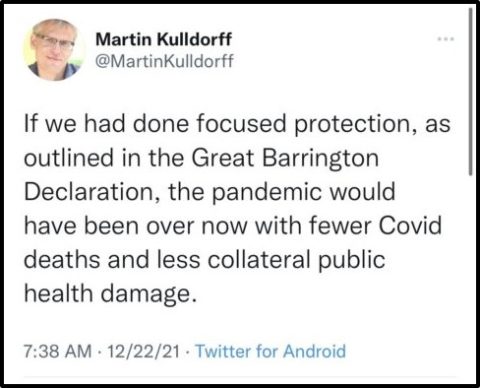
This too is nonsense, and Dr. Kulldorff never provides any evidence for these grandiose claims. It’s was always just a fantasy that “not vulnerable” people could be easily identified and then completely walled off from “vulnerable” people until herd immunity was reached. The pandemic would not have been over in 3-6 months had we let the virus rip through unvaccinated, young people. Some places tried that. They were falsely told they had “protected the vulnerable”, when in fact the vulnerable had been purposefully left defenseless and exposed. One country that hoped to achieve herd immunity through pediatric infections was instead rewarded headlines that read, “Children Drive Britain’s Longest-Running Covid Surge” and “Twice as Many People Died With Covid in UK This Summer Compared With 2021“.
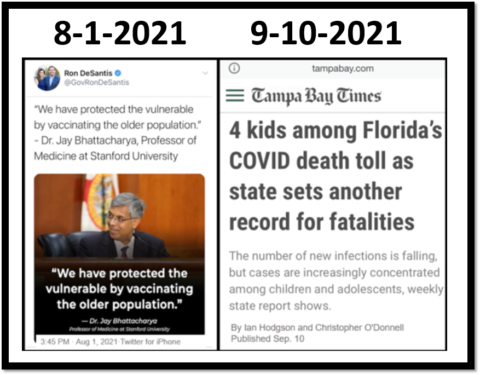
Lockdowns “postponed the inevitable”, thankfully
Of course it’s unambiguously good that measures to control the virus allowed countless millions of people to avoid it until after they were vaccinated and medical care had improved. A fully vaccinated person who contracts COVID today has much better odds of a good outcome than someone who contracted it in March of 2020. Although Dr. Kulldorff will never admit it, even children benefit from vaccination. Someone who contracts COVID in 2030 will be better off still. It’s good to try to postpone the inevitable. Even Dr. Bhattacharya wisely chose to postpone the inevitable until August 2021 after he was vaccinated.
Perhaps my position reflects my experience working throughout the pandemic at Bellevue Hospital in New York City. I saw what the virus could do to unvaccinated people, even those deemed “not vulnerable.” While we all regret the toll the virus took on essential workers, like my co-workers, it’s good that measures were taken to shield everyone else. It’s ridiculous to claim that essential workers would have been better off if only more contracted COVID in 2020.
Had the “laptop class” been infected en masse then the catastrophe that befell us in New York City and elsewhere would have been much worse. No one had treated this virus before, hospitals were deluged as it was, and the morgues were literally overflowing with bodies. Giant refrigerated trucks were parked outside my hospital to store them all. The carnage was from the virus, not the lockdowns.
Dr. Kulldorff, himself an exemplar of the laptop class par excellence, witnessed this all from his living room, which is just where he should have been. We essential workers wanted everyone, even sheltered doctors like him, to avoid the virus. So he’ll have to take my word for it, but no one in the hospital at that time bemoaned the fact that lockdowns protected the laptop class. I’ve still yet to hear anyone in my hospital make this complaint. Ironically, it’s only the laptop class that complains locksdowns prevented them from getting COVID before they were vaccinated.
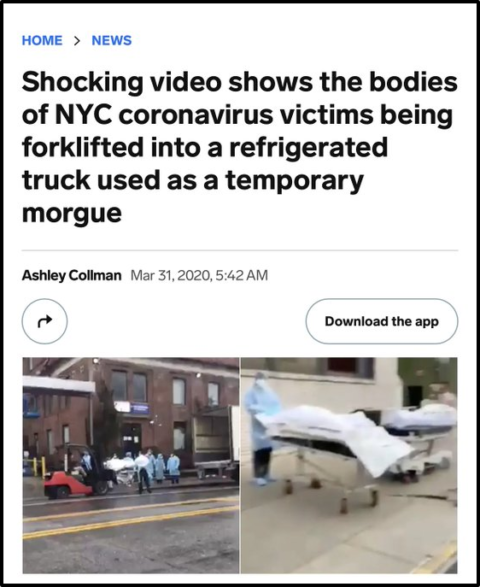
Though Dr. Kulldorff disparages lockdowns by saying they merely “postponed the inevitable,” so do seat belts and smoking cessation programs. Beyond just “not dying”, there can be great value in postponing the inevitable. A core goal of medicine is to postpone the inevitable, and one analysis from May 2020 found:
36,000 fewer people would have died if social distancing measures had been put in place across the U.S. just one week earlier.
Sadly, millions of people failed to take advantage of the gift of a few extra months before they contracted COVID. Doctors tricked them into believing they were “not vulnerable” and that getting the vaccine was therefore “ill-advised“. Some of these people turned out to be vulnerable after all, and many of them expressed regret about not getting vaccinated just before COVID killed them. Dr. Kulldorff treated exactly zero of these patients, some of whom reacted with outrage and violence towards healthcare workers who actually have real-world responsibility.

South Korea, New Zealand, and the USA
Comparisons between countries can be tricky. Countries with older, sicker populations will fare worse than countries with younger, healthier citizens. Cultural factors, such as the willingness to wear masks, get vaccinated, and the ability to stay home when sick, matter tremendously. So do living arrangements, the availability of advanced healthcare, and the reliability of reporting metrics. The timing of lockdowns matters, and the word “lockdown” means different things in different countries. The lockdown in Florida was very different from the lockdown in China. Moreover, the pandemic is not over and its effects will take years to manifest and understand.
Nonetheless, enough time has elapsed that we can begin to get a sense of whether or not South Korea and New Zealand benefitted from their efforts to keep COVID cases low. Everyone agrees that South Korea and New Zealand acted aggressively to suppress COVID cases. Both countries had a negligible number of COVID cases the first two years of the pandemic, and Dr. Kulldorff has repeatedly acknowledged that lockdowns are the main reason why.
The numbers don’t lie. South Korea and New Zealand couldn’t keep the virus away forever, but they suffered many fewer deaths per capita than the US and nearly every other country in the world. Over 800,000 Americans would be alive today if the US had their death rate.
Moreover, while no one pretends lockdowns were harmless, I’m unaware of evidence that South Korea and New Zealand suffered “irreparable damage” from their COVID policies, at least compared to other countries. Students in all three countries (USA, South Korea, New Zealand) suffered from remote learning and school closures, which were often due to the virus, not overly-cautious politicians. Even Sweden had to close high schools for awhile. While it’s fashionable amongst the laptop class to blame lockdowns for everything bad that has happened since, neither South Korea nor New Zealand suffered “enormous collateral damage on cancer, cardiovascular disease, diabetes, tuberculosis, mental health, education” as far as I know.
So the real question is this: Did South Korea and New Zealand damage themselves by postponing the inevitable, or would the US have benefitted had it tried a bit harder to postpone the inevitable? You tell me.
